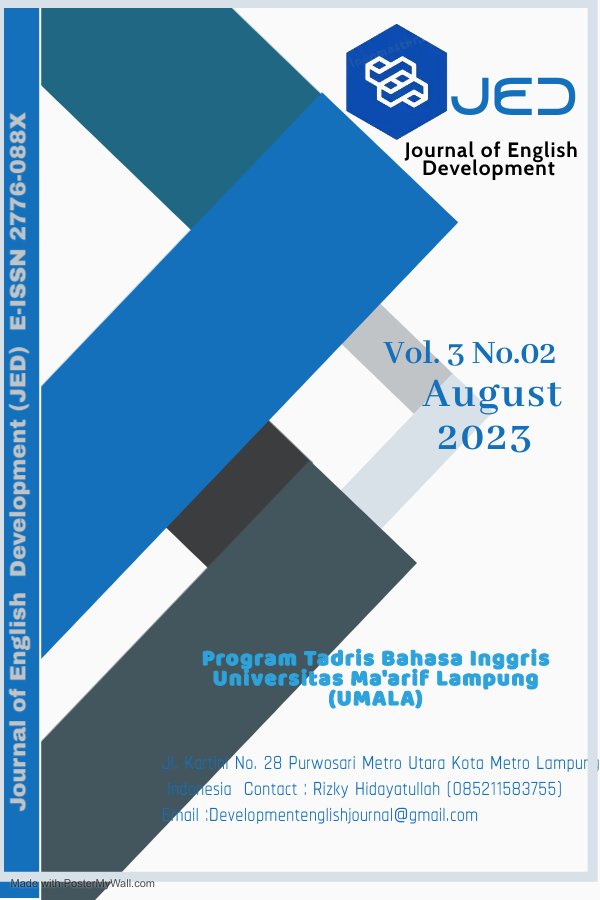EFL Learners’ Perception on The English Reading Instruction with Non Fiction English Texts
English
DOI:
https://doi.org/10.25217/jed.v3i02.4162Keywords:
EFL learners’ perception, English reading instruction, non fiction English textsAbstract
The present investigation was about to highlight whether the EFL learners had positive perception or not on English reading instruction with non fiction English texts. A design of experimental research which chiefly focused on the descritpive analysis was utilized. The sample was chosen purposively which it comprised of 17 male students and 15 female students of junior high school in Palembang. 10 question items were accordingly designed as a primary instrument in a close-ended questionnaire. However, there were twenty participants of which consisted of 5 male students and 15 female students filled out the questionnaire based on the time given. The research findings showcased that mostly the participants had positive responses (strongly agree and agree) due to the use of non fiction English text in English reading instruction. Thus, it could be concluded that the there was positive perception on the participants’ reading comprehension with integration of non fiction English text in English reading class.
References
Alfassi, M. (2004). Reading to learn: Effects of combined strategy instruction on high school students. The Journal of Educational Research, 97(4), 171-185.
Alshumaimeri, Y. (2011). The effects of reading method on the comprehension performance of Saudi EFL students. International Conference on EducationInternational Electronic Journal of Elementary Education, 4(1), 185–195.
Cain, K., & Oakhill, J. (2011). Matthew effects in young readers: Reading comprehension and reading experience aid vocabulary development. Journal of learning disabilities, 44(5), 431-443.
Carrell, P. L. (1987). Content and formal schemata in ESL reading. TESOL Quarterly, 21(3), 461-481.
Day, R. R., & Bamford, J. (1998). Extensive reading in the second language classroom. Cambridge: Cambridge University Press.
Dorn, L. J., & Soffos, C. (2005). Teaching for deep comprehension: A reading workshop approach. Portland, ME: Stenhouse
Dreyer, C., & Nel, C. (2003). Teaching reading strategies and reading comprehension within a technology-enhanced learning environment. System, 31(3), 349-365.
Duke, N. K., Bennett-Armistead, S. V., & Roberts, E. M. (2002). Incorporating informational text in the primary grades. In Comprehensive reading instruction across the grade levels: A collection of papers from the Reading Research 2001 Conference (p. 46). Newark, DE: International Reading Association.
Duncan, G. J., Dowsett, C. J., Claessens, A., Magnuson, K., Huston, A. C., Klebanov, P., ... Japel, C. (2007). School readiness and later achievement. Developmental Psychology, 43, 1428–1446.
Feng, A. X., VanTassel-Baska, J., Quek, C., Bai, W., & O’Neill, B. (2005). A longitudinal assessment of gifted students’ learning using the integrated curriculum model (ICM): Impacts and perceptions of the William and Mary Language Arts and Science Curriculum. Roeper Review, 27, 78-83.
Flowers, T. A., & Flowers, L. A. (2009). Nonfiction in the early grades: Making reading and writing relevant for all students. Journal for the Liberal Arts and Sciences, 13(2), 40-50
Gabriella., & Diptoadi, V.L. (2019). Students’ perception of extensive reading activity through reading log. Magister Scientiae, 46.
Grabe, W. (2009). Reading in a second language: Moving from theory to practice. New York: Cambridge University Press.
Grabe, W., & Stoller, F. L. (2011). Teaching and researching: Reading. New York: Routledge.
Jacobs, G. M., & Farrell, T. S. C. (2012). Teachers sourcebook for extensive reading. Charlotte, NC: Information Age Publishing.
Jacobs, G. M., & Renandya, W. A. (2015). Making extensive reading even more centered. Indonesian Journal of Applied Linguistics, 4(2), 102–112.
Kheirzadeh, S., & Tavakoli, E. (2012). The Causes of Reading Difficulty: The Perception of Iranian EFL Post-graduate and Under-graduate Students. Journal of Language Teaching and Research, 3(1). https://doi.org/10.4304/jltr.3.1.147-152.
Lien, H. Y. (2017). EFL college learners’ perceptions of self-selected materials for extensive reading. The English Teacher, 39, 194-204.
Lutz, S. L., Guthrie, J. T., & Davis, M. H. (2006). Scaffolding for engagement in elementary school reading instruction. Journal of Educational Research, 100, 3-20.
McLean, S., & Rouault, G. (2017). The effectiveness and efficiency of extensive reading at developing reading rates. System, 70, 92-106. https://dx.doi.org/10.1016/j.system.2017.09.003.
Mullis, I. V. S., & Martin, M. O. (Eds.). (2021). PIRLS 2021 assessment framework. Chestnut Hill, MA: TIMSS & PIRLS International Study Center, Boston College and International Association for the Evaluation of Educational Achievement (IEA).
Nakanishi, T. (2015). A meta-analysis of extensive reading research. TESOL Quarterly, 49, 6e37. https://doi.org/10.1002/tesq.157.
Nuttall, C. (2005). Teaching reading skills in a foreign language. Oxford, England: Macmillan Education.
Richards, J. C., & Renandya, W. A. (Eds.). (2002). Methodology in language teaching: An anthology of current practice. Cambridge, NY: Cambridge university press.
Satriani, E. (2018). Reading Comprehension Difficulties Encountered by English Students of Islamic University of Riau. J-SHMIC : Journal of English for Academic, 5(2). https://doi.org/10.25299/jshmic.2018.vol5(2).1885
Schatz, A., & Krashen, S. (2006). Attitudes Toward Reading in Grades 1-6: Some Decline in Enthusiasm But Most Enjoy Reading. Knowledge Quest, 35(1), 46.
Slavin, R., & Madden, N. (1999). Effects of Bilingual and English as a Second Language Adaptations of Success for All on the Reading Achievement of Students Acquiring English. Journal of Education for Students Placed at Risk JESPAR, 4(4), 393-416.
Suk, N. (2016). The Effects of Extensive reading on reading comprehension, reading rate, and vocabulary acquisition. Reading Research Quarterly, 0(0), pp. 1–17. https://doi:10.1002/rrq.152
Tamsi, R. K. (2013). The implementation of skimming and scanning strategies in teaching reading narrative text to the tenth-grade students of SMAN 21 Surabaya. Retain, 1(2), 1-7.
Widiati, U., & Cahyono, B. Y. (2006). The teaching of EFL reading in the Indonesia context: The state of the art. TEFLIN Journal, 17(1), 36–58. https://doi.org/10.15639/TEFLINJOURNAL.V19I1/1-17.
Zua, B. (2017). Reading: When and Why. Journal of Education & Social Policy, 4(2), 128-132.

Downloads
Published
How to Cite
Issue
Section
License
Copyright (c) 2024 Jaya Nur Iman, Nike Angraini

This work is licensed under a Creative Commons Attribution-ShareAlike 4.0 International License.





